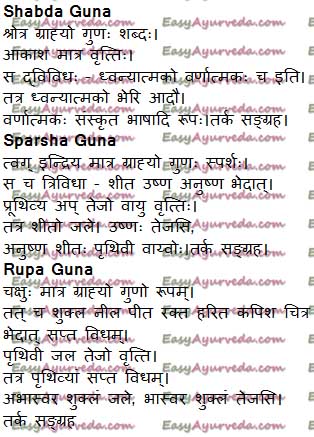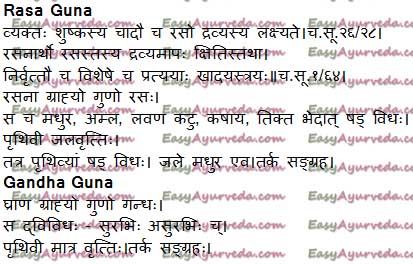Qualities Of Five Basic Elements (Vishishta Gunas) – Classification, Uses
By Dr Raghuram Y.S. MD (Ay) & Dr Manasa, B.A.M.S
The five basic elements – earth, water, fire, air and ether have their own unique qualities. These are explained as Vishishta Gunas (special qualities) in Ayurveda.
Read – Dravya: Meaning, Ayurvedic Explanation
Table of Contents
Visista qualities
Vishista Gunas – i.e. special qualities, five in number.
Vishishta qualities
Visista qualities are types of Adhibhoutika qualities. Since these qualities are the special qualities of five elements of nature, they are called ‘special qualities of the elements of creation’.
Read – Panchamahabhuta: Application, Areas of Utility in Ayurveda treatment
They are 5 in number –
- Shabda (sound) – it is the special quality of space element
- Sparsha (touch) – special quality of air element
- Rupa (sight) – special quality of fire element
- Rasa (taste) – special quality of water element
- Gandha (smell) – special quality of earth element
Knowledge of these 5 special qualities is said to be mandatory for obtaining success in clinical practice.
Read – Indriya Pancha Panchaka: 5 Fives Of Sense Organs
Shabda Guna – sound
Quality which is received and perceived by sense organ of sound (shrotra indriya) is called sound quality (shabda). It is perceived only by ears.
Sound is a quality of space element (click here to read about space element) and is embedded in the same with an inseparable relationship. The sense organ of hearing is predominantly made up of space element. Therefore it is also related to sound quality embedded in ether element. Sound is said to be special quality (vishista guna) of ether element.
Read – How Knowledge Is Gained Through Sense Organs?
Sound types
Sound is of two types.
- Dhwanyatmaka Shabda –
This form of sound is produced from musical instruments like drums, conch etc. - Varnatmaka Shabda –
This form of sound is produced from vocal sounds in the form of words of different languages we speak. They are called pronounced / vocal sounds, the sound of the language we speak.
Read – Role of Vata Dosha And Its Types In Speech And Voice
Sparsha Guna – touch
Quality which is received and perceived by sense organ of touch (sparshana indriya) i.e. skin is called touch quality (sparsha guna). It is perceived only by skin.
Touch is a quality of air element and is embedded in the same with an inseparable relationship. Skin is predominantly made up of air element. Therefore it also is related to the touch quality embedded in air element. Touch is said to be special quality (vaisheshika guna) of air element.
Touch types
Touch is said to be of three types.
- Sheeta (coldness) – predominantly present in the water element
- Ushna (heat) – predominantly present in the fire element
- Anushna sheeta (neither hot nor cold) – predominantly present in the earth and wind elements
Read – Jnana and Karma Indriyas: Organs Of Sense And Function
Rupa Guna – Vision
Quality which is received and perceived by the sense organ of vision (chakshu indriya), i.e. eye is called vision quality (rupa guna). It is perceived only by eye.
Sight is a quality of fire element and is embedded in same with an inseparable relationship. Sense organ of sight i.e. eye is predominantly made up of fire element. Therefore it is also related to sight / vision quality embedded in fire element. Rupa is said to be special quality (vaisheshika guna) of fire element.
Read –Relation Between Doshas, Sense Organs And Perception
Types of Rupa
This is of seven types.
- Shukla – white
- Neela – blue
- Peeta – yellow
- Rakta – bloody red
- Harita – green
- Kapisha – brown / reddish brown
- Chitra – bright / spotted / mixed / clear
This rupa quality is present in earth, water and fire elements. Water has dull looking whiteness (abhaswara shukla rupa) and fire has bright whiteness (bhaswara shukla rupa).
Read – Anatomy of Eye: Netra Rachana: Ayurveda Perspective
Shloka – Shabda, Sparsha, Roopa

Rasa Guna – taste
Quality which is received and perceived by sense organ of taste (rasana indriya) i.e. tongue is called taste quality (rasa). It is perceived only by tongue.
Taste is a quality of water element and is embedded in the same with an inseparable relationship. The sense organ of taste i.e. tongue is predominantly made up of water element. Therefore it is also related to the taste quality embedded in water element. Taste (rasa) is said to be a special quality (vaisheshika guna) of water element.
Read – Ayurvedic Way Of Teeth Brushing And Tongue Scraping
Knowledge of taste is manifested in the form of sweet, sour, salt etc tastes immediately after dry or wet substances carrying those tastes come in contact with tongue and is also manifested at the end of consuming it.
Tastes are 6 in number i.e. sweet, sour, salt, pungent, bitter and astringent. They form the basis of effective treatment in Ayurveda. Medicines and foods are made up of predominance of one or more of these tastes. Taste is present in earth and water elements. Earth has all tastes other than sweet taste and water has only sweet taste.
Read – Six Tastes Of Ayurveda: Qualities, Benefits, Therapeutic Action (Shad Rasa)
Gandha Guna – smell
Quality which is received and perceived by sense organ of smell (ghrana indriya) i.e. nose is called taste quality (gandha). It is perceived only by nose.
Smell is a quality of earth element and is embedded in the same with an inseparable relationship. Sense organ of smell i.e. nose is predominantly made up of earth element. Therefore it is also related to the smell quality embedded in the earth element. Smell (gandha) is said to be special quality (vaisheshika guna) of earth element.
Read – Bad Prognosis Based On Smell, Touch, Taste, Colour And Voice
Smell types
This quality is of two types.
Surabhi / sugandha – pleasant odor
Asurabhi / durgandha – unpleasant odor
Smell (gandha) quality is present only in earth element.
Read – Substances, Qualities, Action – 9 Ashtanga Hrudaya Sutrasthana
Shloka – Rasa, Gandha

Importance
Importance of Shabdadi Vishishta Gunas in Ayurveda
These are also called as Pancha tanmatras which also participate in the creation of universe.
Knowledge of these 5 special qualities which are related to the cosmos and also to the perception of sense organs, which form the major basis of obtaining the knowledge of substances are also necessary for examination of patient and also for administration of treatment.
Asatmya indriyartha sannikarsha i.e. improper coordination between the sense organs and sense objects is said to be one among the three most important etiological factors in the manifestation of most diseases.
Read – Improper Use Of Sense Organs: A Neglected Cause For Diseases
Excessive, deficit or perverted indulgence in one or more of the sound etc sense objects, special qualities in this instance leads to the manifestation of diseases. At the same time, proper perception brings about good health.
Click to Consult Dr Raghuram Y.S. MD (Ayu) – Email / Skype









